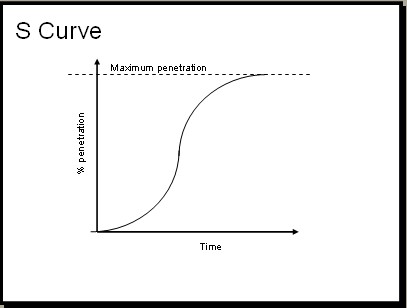Open source textbooks hit key point in the S curve


Demand for your product will grow slowly at first, so you want to keep your prices high and focus your marketing.
Once demand is satisfied, and most buyers are getting their second version of your product, you want to practice value-pricing, with lower margins, to maximize profit.
It's in between these low-sale and high-sale states that we have the most fun. Demand grows exponentially, but you have to scale, getting big as fast as the market, if you're to make the most from your invention.
Flat World Knowledge is about to hit that key inflection point on the s-curve. They face the problem of getting big, fast. This is where the big money comes in, and the key decisions are made, that decide the fate of the whole industry.
Flat World president Eric Frank called last week to say he's up for the challenge. He was preparing to address a faculty convocation at Houston Community College, which has 25 campuses. It's one of those big accounts that is going to fall somewhere, soon, as the industry is transformed.
So far, the main way traditional publishers are dealing with the threat of open source textbooks, which can be edited constantly and given away as HTML files, is through rentals.
Rather than have kids buy textbooks at the start of the semester and then find a way to sell them back when they're done, firms like Barnes & Noble are working with college bookstores to make this transaction automatic. My kids save half on their textbook costs and there is less hassle. It's a good thing.
But Flat World is growing fast. Some 150,000 students will have access to its free books this year, with 1,300 faculty members on the program. Flat World profits by selling study guides, PDFs, audiobooks, and printed copies. Authors make about as much as they did before.
This week, the Chronicle of Higher Education is reporting on a school of business that is committing its whole program to Flat World. This is just the tip of an iceberg of demand now forming, as three trends hit the industry, Frank said:
- The bookstore model is under growing pressure. Schools are looking to replace it.
- Teachers say the print book cost problem is hurting their ability to teach.
- Teachers will soon be able to customize their textbooks with Flat World.
Another important fact, Frank said, is that textbooks are a long tail business. Just 125 titles represent 55% of the market. Flat World is now moving toward filling all those niches -- Frank called it a tipping point.
Cloud computing and tablets like the iPad are just accelerating these trends, Frank said. He is now looking to consolidate his distribution system, knowing that demand is coming, and knowing that larger companies are soon going to be sniffing around his market space.
"We're great at author acquisition, book development, sales and marketing. We're looking for a distribution partner."
Open source textbook publishing, in other words, is no longer a gangly freshman. This year it has to take the MCAT. The pressure is on.